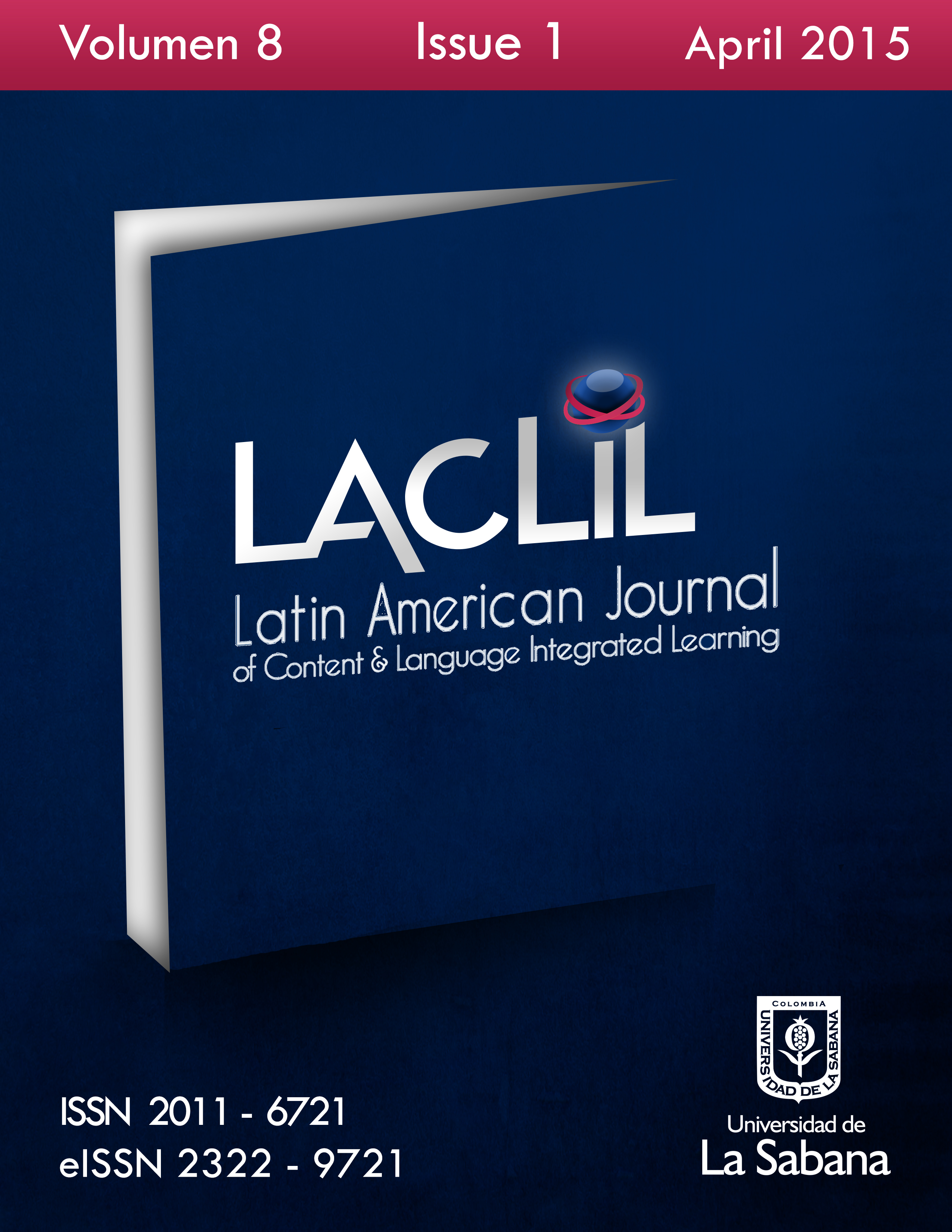Content and language symbiosis in a maieutic, translanguaging pattern: An exploratory practice in Italy
DOI:
https://doi.org/10.5294/4730Keywords:
modelo CLSL, translingüismo, intermediación lingüística, marco de aprendizaje, inter-aprendizaje, alerta pedagógica.Abstract
This paper aims to introduce pre- CLIL through the CLSL (Content & Languages (L1/L2) Shared Learning) model, which operates as a bridge for a full CLIL immersion. It analyses the characteristics of this new learning model that springs up from immanent needs of Italian educational reality by reporting results on the way content and language develop in a translanguaging pattern. It further discusses the impact it may have on a national and international level by observing that the gradual nuances of pre- CLIL tend to soothe and mainly vivify the learning experience. At the same time the stakeholders’ voices extend the role of the CLSL model by giving life to a democratic and diversified learning that can perceive the alternative CLIL practice in a tripartite mode. CLSL emerges as a dynamic phase that enhances inter-content and linguistic competences by rendering language and content learning through code-switching dialogic and participatory instigating a new inter-learning experience.
Downloads
References
REFERENCES
Agolli, R (2013). A penetrating CLIL praxis in Italian mainstream education: Stemming novelties and visions. Research Papers in Language Teaching and Learning, 4, 138-157. Available from: http://rpltl.eap.gr/current-issue/table-of-contents/16-renata-agolli
Agolli, R (2014). Perceiving CLIL nuances. Iatefl Voices, 237, 12.
Byram, M., Feng, A. (2004). Culture and language learning: teaching, research and scholarship. Language teaching 37(3), 149-168. Retrieved from: http://dro.dur.ac.uk
Clegg, J. (2007). “CLIL in European schools and its relations with minority and mainstream education: Clil e formazione degli insegnanti (Il progetto europeo LICI): Atti del convegno: Torino, Italia.
Council of Europe (2001). Common European Framework of references of languages: learning, teaching, assessment. Cambridge: Cambridge University Press.
Coyle, D., Hood, P., Marsh, D. (2010). CLIL Content and Language Integrated Learning, Cambridge: Cambridge University Press.
Di Martino, E., Di Sabato, B. (2012) CLIL implementation in Italian schools: Can long-service teachers be retrained effectively? The Italian protagonists’ voice. Latin American Journal of Content and Language Integrated Learning, 1(2), 73-105.
Eurydice (2006). “CLIL at School in Europe”. Retrieved [11.01.2014] from: http://www.eurydice.org/portal/page/portal/Eurydice/showPresentation?pubid
Fullan, M. (2001). Leading in a culture of change. San Francisco: Jossey- Bass.
Gibson, M (2012, February, 24). Integrating critical thinking skills in L2 content based learning: decision making optimization based on conflict resolution. Conference Paper: 24th February, University of Navarra, Spain.
Giroux, A. H. (2010). Dumbing down teachers: Rethinking the crisis of public education and the demise of the social state. Review of Education, Pedagogy, Cultural studies, 32 (45), 339-381. Routledge: Taylor & Francis Group.
Hall, N., Sham, S (2007). Language brokering as young people’s work: evidence from Chinese adolescents in England. Language and Education, 21 (1), 16-30.Taylor & Francis Online.
Hardman, J (2010). Variation in semiotic mediation across different pedagogical contexts. Education as Change, 14(1), 91-106.
Hodgson, N (2009). Educational research, governmentality and the construction of the cosmopolitan citizen. Ethics and Education, 4 (2), 177-187. Routledge, Taylor & Francis Group.
Hunt, M. (2011). UK teachers’ and learners’ experiences of CLIL resulting from the EU- funded project ECLILT. Latin American Journal of Content & Language Integrated Learning, 4(1), 27-39. Available from: http://www.laclil.org
Jee et, al (2010). Analogical thinking in Geoscience education. Journal of Geoscience Education, 58, 2-13. National Science Education.
Kong, S (2014). Collaboration between Content and Language Specialists in late Immersion. The Canadian Modern Language Review, 70 (1), 103-122. University of Toronto Press.
Lantolf, P,J. (2000). Sociocultural theory and second language learning. Oxford: Oxford University Press.
Lyster, R (2007). Learning and teaching languages through content: A counterbalanced approach. Amsterdam, Netherlands: John Benjamins.
Lucietto, S. (2010). Studio documentale e raccolta dati utili alla valutazione del Programma di Sperimentazione “Scuole Plurilingui”, Provincia Autonoma di Trento. Doctoral Dissertation: Bolzano: Free University of Bolzano.
Moate, J. (2011). Reconceptualising the Role of Talk in CLIL Apples- Journal of Applied Laguage Studies,5 (2), 17-35. Available from: http:// www. apples.fi
MIUR (2012). La metodologia CLIL nei Licei Linguistici e Scientifici. Seminario di studio , 28th November, Rome, Italy.
O’ Leary, Z. (2010). The essential guide to doing your research project. Second edition. Sage Publications Ltd.
Pang, K., Ross, C. (2010). Assessing the Integration of Embedded Metacognitive Strategies in College Subjects for Improved Learning Outcomes: A New Model of Learning Activity. The Journal of Effective Teaching, 10 (1), 79-97. University of Texas.
Pawan, F., Craig, A.D. (2011). ESL and content area teacher responses to discussions on English language learner instruction. TESOL Journal, 2 (3), 293-311.
Rossi- Holden, L (2008). “ L' Inglese pigliatutto della Gelmini, Via alle proteste, e la UE si prepara” La Repubblicca .It, 1-2. Retrieved [29.09.2011] from: http// www.repubblica.it///
Thomas, G. (2009). How to do your Research Project. Sage Publications Ltd.
Waters, A (2009). Managing innovations in English language education. Language Teaching, 42(4), 421-458. Cambridge University Press.
Downloads
Published
How to Cite
Issue
Section
License
This Journal and its articles are published under the Creative Commons CC BY 4.0 DEED Attribution 4.0 International license. You are free to: Share — copy and redistribute the material in any medium or format for any purpose, even commercially. Adapt — remix, transform, and build upon the material for any purpose, even commercially. The license cannot revoke these freedoms as long as you follow the terms of the license.








